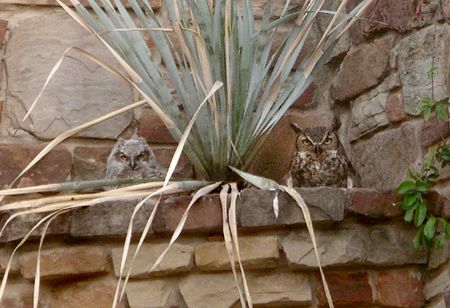
abandoned owl egg in 2009
 abandoned owl egg in 2009 |
Birds seem particularly adept at accommodating human dwellings and structures. While there are some species that decline when we push, there are others that just respond with a shove. Almost everyone has seen a swallow, wren, sparrow or dove nest in or around their own house. It is easy to see how small birds can find suitable nesting places, but what about bigger birds, or those that require more territory? Well, some of them manage just fine. In fact, even those magnificent nocturnal hunters, owls, are capable of sharing space with us.
There are a number of owls that live in south Austin. I once met a Burrowing Owl on a walk in the Sunset Valley shopping center, but that was decades ago. I suspect that species has been pushed out by development. Our neighborhood, though, still hosts both Screech and Great Horned Owls. I sometimes hear the former on summer nights, their odd call eerily suggestive of a tiny horse laughing. The much larger Great Horned Owls call to their mates in December and January; their booming voices easily heard through the roof as they sit in the trees over our house. By February, the female is incubating eggs and the young fledge at the beginning of May.
One particular pair of owls has taken up residence in a very public place: the Lady Bird Johnson Wildflower Center. I first became aware of the owls in 2009, when they attempted to nest in one of the narrow planters on the side of the tower building. The stonework must have seemed like a natural cliff, and there was plenty of space for the female as she sat on her eggs. It was possible to look down on the owl and her egg from higher up the tower. This obviously wasn't a satisfactory arrangement from the owl's point of view, as she abandoned the nest. One egg remained for a short time but then disappeared. The following year was another failed nesting attempt.
 baby and mother in 2012 |
 the fledgling trio in 2014 |
The owls obviously improved their nesting technique and, in 2011, the female chose a corner planter above the main entry arch to the gardens. The only obvious plant in that niche was a Sotol, a yucca-like plant with short thorns on the sides of the long narrow leaves. Being a desert-adapted plant, Sotol was a good choice for a planting high up on a building, where the drainage was good but the soil was often dry.
When I first saw the owl in that location, I wasn't sure it was a live creature. It stayed perfectly still and was far enough away that I couldn't make out much detail. I watched very carefully, though, and finally saw it open its eyes a bit. I'm not the only one that was fooled at first. I often heard visitors asking if it was a real owl or just a concrete or plastic model put there. Well, once the babies' heads appeared, it was evident to everyone that the owls were real. Another clue was the litter of feces, owl pellets, and animal parts that could be found under the nest every day.
Beginning in 2010, I have been leading weekly fauna surveys at the Wildflower Center from Feb. through mid-Dec., so our database has records that are more reliable than my not-so-accurate memory. That first brood, in 2011, consisted of three nestlings. The record for the next couple of years was equally admirable. This year, right on schedule, the female was on her nest when we had the first survey in Feb. After seeing how the owl on her nest looked in previous years, it was evident this time that she was sitting lower in the planter than before. For several weeks, we tried in vain to see if she was a bit higher, which would indicate that she had growing babies underneath. Just when we began to worry that perhaps something might have happened to her mate and maybe she didn't really have nestlings, there were finally sightings of the fluffy white heads of the babies. The nesting cavity in the planter was obviously a bit deeper than in previous years, either because of the soil settling or the owl gradually shifting it.
This year, sometime during the last week in April, three owls left their nest in the planter over the entrance archway. Over the past four years, thousands of people have had the rare chance to see a wild owl nesting in a very public place, and many have also seen the fluffy gray heads of the young just before they get ready to fledge. A few lucky folks have witnessed the mother feeding her babies. Their diet consists mostly of birds and small mammals. Considering the large populations of rabbits and cotton rats around the gardens, there is no dearth of prey for these majestic birds. I, for one, am certainly looking forward to their return next year.